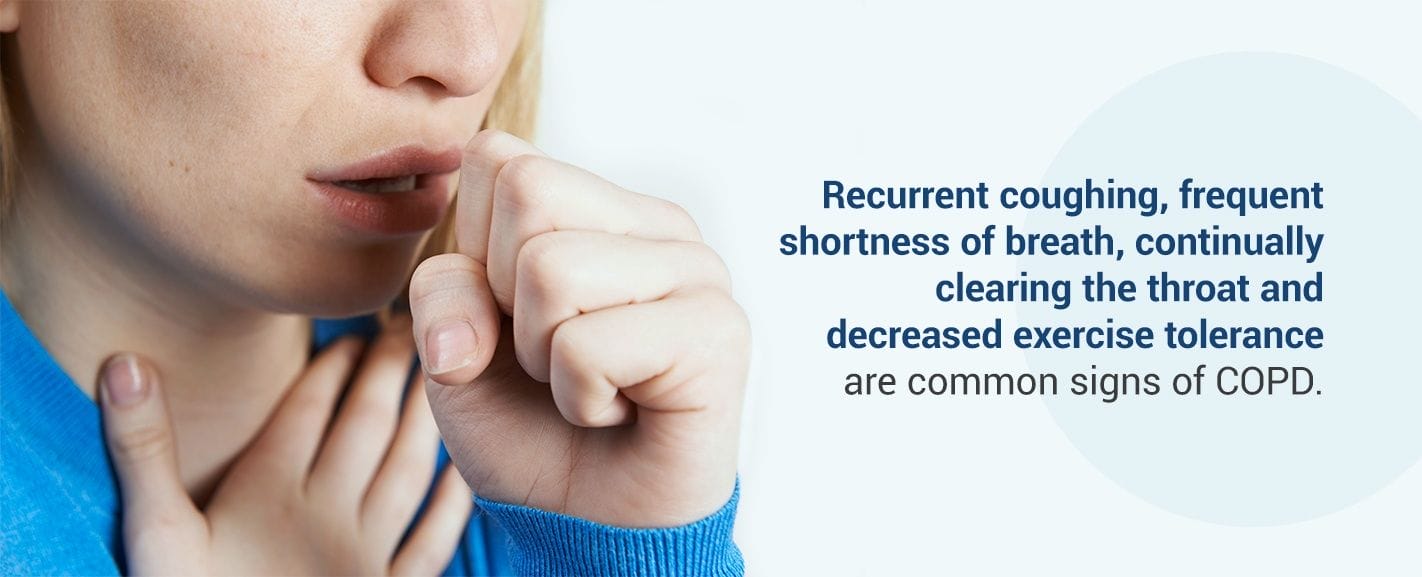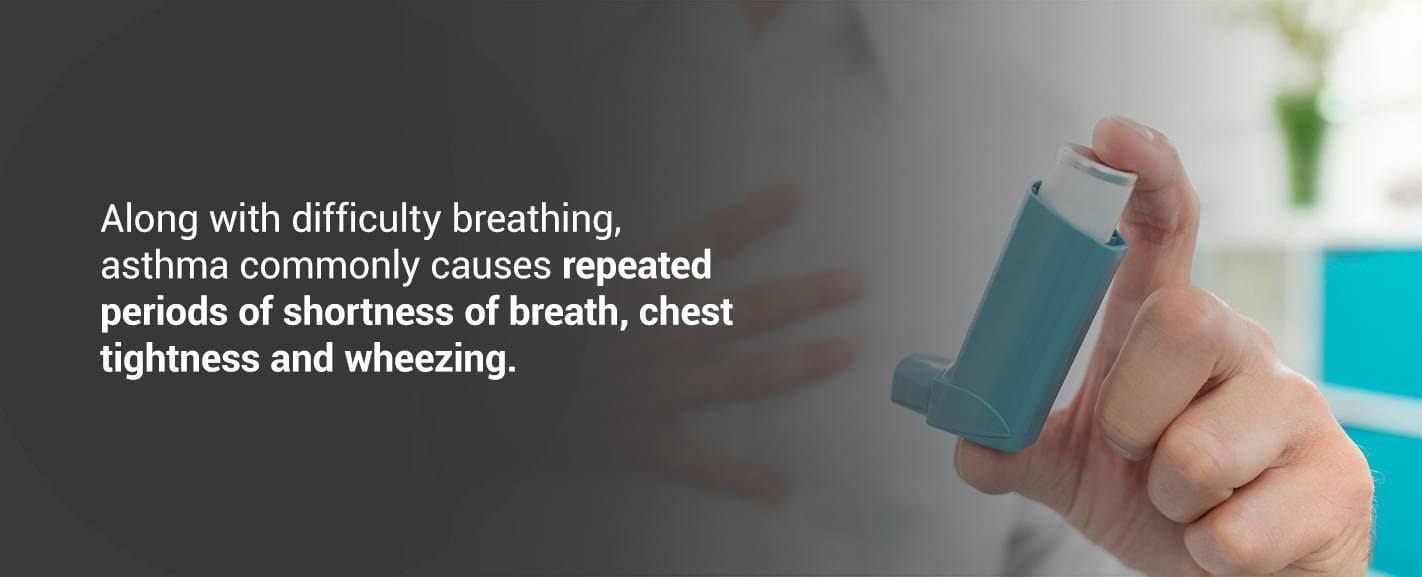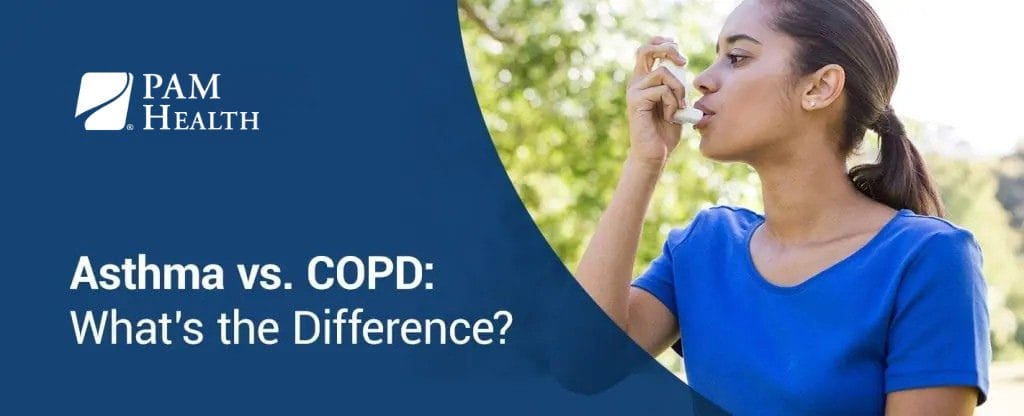It is no surprise that asthma and chronic obstructive pulmonary disease (COPD) are often mistaken for one another — they are both conditions that affect the lungs and make breathing more difficult. Despite their many similarities, asthma and COPD are not the same. In honor of November being National COPD Awareness Month, it is time to finally clear up the question of whether asthma and COPD are the same thing.
Below, we will look at the definitions of the two diseases, along with the symptoms, causes and treatments for each. We will also discuss when to see a medical professional for lung damage to help raise COPD awareness this month.
Explore Cardiopulmonary Rehabilitation Offered by PAM Health
What Is the Difference Between COPD and Asthma?
Before discussing the similarities and differences between asthma and COPD, here is a brief definition of each condition.

COPD
COPD is a lung disease that is not fully reversible. It occurs when chronic interference with lung airflow negatively impacts breathing. The major cause of COPD is exposure to tobacco, whether by directly smoking or experiencing secondhand smoke. Recurrent coughing, frequent shortness of breath, continually clearing the throat and decreased exercise tolerance are common signs of COPD.
COPD is the general name given to a group of lung diseases. The main lung diseases involved in COPD are emphysema and chronic bronchitis, both of which are considered different forms of COPD by many researchers and doctors — such as those at the World Health Organization (WHO). Emphysema occurs when the alveoli — small sacs in the lungs — get damaged, while chronic bronchitis happens when the tubes carrying air to the lungs become inflamed.

Asthma
Asthma is a respiratory condition characterized by spasms of the bronchi and difficulty breathing caused by narrowed and inflamed airways in the lungs. Along with difficulty breathing, asthma commonly causes repeated periods of shortness of breath, chest tightness and wheezing.
Those with asthma are especially sensitive to allergens and other things that can be irritating when breathed in, known as irritants. Often referred to as triggers, allergens and irritants can lead to an asthma attack, which is when excess mucus causes the airways to become swollen and tight. Asthma attacks can range from mild to moderate or severe.
With the proper medical attention and treatment, asthma can be completely reversible and breathing can return to normal.
COPD vs. Asthma
Both COPD and asthma are lung diseases that make it hard to breathe by causing swelling in the body’s airways. However, asthma can get better and its symptoms may come and go, whereas COPD comes with constant symptoms that may worsen over time. Asthma can also affect anyone, while COPD symptoms typically develop in people over the age of 40.
Although it is rare, it is possible to have COPD and asthma together, which is known as asthma-COPD overlap syndrome (ACOS).
Evaluating Asthma and COPD Symptoms and Causes
Because they are both lung diseases that inhibit regular breathing, asthma and COPD share many similarities in both symptoms and causes. The inflammatory immune reactions that cause an asthma attack are often triggered by airborne substances like smoke, dust, pollen, pet dander, mites and mold spores. COPD is caused by long-term exposure to lung irritants, such as cigarette smoke, toxic fumes and chemicals, which results in damaged lung cells.
While there are many external factors like tobacco smoke and secondhand smoke that can cause COPD or asthma, inherited genetic factors can also play a role in susceptibility to either of the diseases. For instance, alpha-1 antitrypsin deficiency is also referred to as inherited emphysema. Because of their similar causes and the way they affect the lungs, COPD symptoms can oftentimes look like an asthma attack and vice versa.
Here are the symptoms that may be found in both those with asthma and those with COPD:
- Shortness of breath: This includes feeling out of breath, winded or unable to take a deep breath.
- Chest tightness: Chest tightness manifests as pressure felt in the chest area due to inflamed and swollen airways.
- Coughing: This includes excessive coughing to clear the airways.
- Wheezing: Wheezing includes a squeaking or whistling sound in the chest when trying to breathe.
- Exercise intolerance: Someone may experience difficulty breathing or dizziness while exercising.
- Anxiety: Anxiety can manifest as increased anxious thoughts and a higher heart rate.
Although the symptoms of COPD and asthma have a great amount of overlap and similarities, there are some subtle differences among them. For example, the chronic cough often experienced by those with COPD tends to produce far more phlegm and mucus than the amount produced by asthma. For this reason, a chronic cough is much more common in those with COPD than with asthma.
Additionally, while a person with asthmatic breathing can return to normal between asthma attacks, breathing typically does not return to normal for those with COPD. Someone diagnosed with COPD may also have chronic blueness around their fingernail beds or lips, known as cyanosis, which is not a typical symptom for someone with asthma. Cyanosis is a side effect of COPD because the disease hinders the ability to take in the necessary amount of oxygen to maintain a healthy color.
Because COPD is a progressive disease, its symptoms begin slowly and gradually become worse as time goes on. Someone may start with no symptoms or relatively mild symptoms and develop more severe ones over many years. On the other hand, asthma may get worse with time, but it is far less common.
Diagnosing Asthma and COPD
With all the similarities between asthma and COPD symptoms, it can be challenging to diagnose each disease correctly without mistaking one for the other. Asthma is the most common alternative diagnosis for COPD. However, it is important to correctly identify which condition a patient is dealing with so they can receive the proper treatment.
When a patient has symptoms that pertain to both asthma and COPD, there are a few key factors that differentiate the two. To develop an accurate diagnosis, medical professionals will ask patients dealing with breathing issues specific questions about their symptoms, such as what time of day they feel the worst. They will also inquire about the patient’s medical, family and smoking histories and exposure to irritants, as well as gases or vapors.
By asking these pointed questions, a doctor will get the information they need to determine which key factors are present in the patient. Below are the three primary features of each disease that help medical professionals determine the correct diagnosis:
1. Age of Onset
Age is typically the first variable accounted for when a lung disease presents itself because the patient’s age is often the distinguishing feature between asthma and COPD. While asthma is usually diagnosed at the first signs of difficulty breathing when the patient is a child, COPD is a far more prevalent diagnosis for older individuals. If the patient is over the age of 40 and has a history of smoking, there is a greater likelihood that COPD is the correct diagnosis.
2. Causes
After evaluating age, examining what causes the symptoms in the patient is a great way to get to the bottom of the disease. Although experts are still unsure about the exact cause of asthma, medical professionals suspect the disease is most likely due to a combination of environmental and genetic factors. Common environmental factors that can stimulate an asthma attack include pollen, dust and smoke.
In contrast, the cause of COPD is much more clear-cut and easy to recognize. Smoking stands out as the main reason people develop COPD, with about 85%-90% of all COPD deaths being attributed to habitual smoking. In addition to smoking, high exposure levels to air pollution, secondhand smoke and certain chemicals can also be responsible for the development of COPD.
Alpha-1 antitrypsin deficiency, the genetic disorder referenced earlier, is another contributing factor to COPD, but only for about 2%-3% of COPD cases.
3. Triggers
As stated above, an asthma attack is oftentimes caused by exposure to certain airborne substances in the environment, like pollen, dust and smoke. These substances are called triggers and can be a strong indication that asthma is to blame for a patient’s breathing problems. Being out in the cold air and performing rigorous physical exercise may also worsen asthma symptoms.
On the other hand, triggers for COPD symptoms are more internal. Respiratory tract infections like influenza and pneumonia are common triggers for COPD. However, it is possible for some people with COPD to experience symptoms without a known trigger, regardless of whether they were being active or resting at the time.

Monitoring, Managing and Treating Asthma and COPD
Once the conditions are diagnosed, the medications used to manage asthma and COPD are similar and usually involve an inhaler of some sort. However, other types of treatment and therapies for each disease tend to differ. This section will explore the different approaches used to monitor and manage asthma and COPD in everyday life.
Asthma Treatment
There are many treatment options for those diagnosed with asthma for managing the condition. Overall, treatment for asthma includes avoiding asthma attack triggers, tracking the frequency and severity of symptoms and taking medicine. Avoiding triggers can involve anything from keeping pets out of the house to staying indoors when the pollen count is high.
To help monitor asthma symptoms, patients can use a peak flow meter. Essentially, a peak flow meter is a device that measures the rate at which someone can blow air out of their lungs. By regularly measuring their peak flow, a patient can keep tabs on whether their asthma is getting better or worse.
Based on a patient’s peak flow meter readings, their primary care doctor or allergist can tell them how much medicine to take and when. Asthma medications can be divided into four main categories:
- Long-term control medications: These medicines are taken regularly to control chronic asthma symptoms and prevent attacks. Inhalers are often used to deliver long-term control medications for asthma.
- Rescue medicines: These quick-relief medicines are taken as needed to treat an asthma attack and provide short-term symptom relief.
- Allergy-induced asthma medications: Specifically taken for allergy-induced asthma, this medicine is taken regularly or as needed to decrease the body’s sensitivity to a particular allergen. This treatment method includes allergy shots and medications.
- Biologics: Taken along with control medicines, biologics stop underlying biological responses that lead to inflammation in the lungs.
COPD Treatment
Like asthma, there are many different treatment options for managing COPD. Because COPD is a progressive disease, treatment is designed to help control symptoms and reduce the risk of complications. With a combination of lifestyle changes, medication and rehabilitative therapies, COPD’s effects can be mitigated and disease progression may be slowed.
These are the four main strategies for managing COPD:
- Quit smoking: Stopping smoking is the best way to prevent further damage to the lungs. While smoking is the primary trigger for COPD, other irritants should be avoided as well, such as air pollution, chemicals and dust.
- Get vaccines: Getting the proper vaccinations is especially important for people with COPD to decrease their risk of contracting a lower respiratory tract infection. These infections can worsen COPD symptoms and cause more lung damage.
- Use bronchodilators: While there are a few medication options available for managing COPD symptoms, bronchodilators are first-line therapy. Bronchodilators are medicines typically delivered via inhalers to relax the muscles around the airways to make breathing easier. Because bronchodilators may be short- or long-acting, they can be used as needed or daily.
- Join rehabilitation programs: Certain pulmonary rehabilitation programs may be beneficial for those with COPD. These programs allow patients to work alongside a team of health care professionals to receive the information and support they need.
In a life-threatening COPD or asthma situation, emergency treatments include mechanical ventilation, intubation, steroids and oxygen treatment until the crisis has subsided.
Knowing When to See a Professional
Clearly, there are numerous ways to effectively manage asthma and COPD, which means the prognosis for both diseases can be hopeful as long as each condition is caught early. While neither asthma nor COPD are considered curable, asthma is typically easier to control on a daily basis by avoiding triggers and taking the proper medication. As a progressive disease, COPD may get worse over time, but sticking with a physician-prescribed treatment plan can slow the disease’s progression and lessen symptoms.
The first step in successfully managing both conditions is to see a medical professional. Whether you suffer from difficulty breathing, coughing, wheezing or chest tightness or simply have a family history of the disease, you should consider seeking professional help. After consulting with a medical specialist, you will have a better idea of your condition and available treatment options.
It is especially important to receive medical attention specifically intended for your individual condition. Look for a rehabilitation center like Post Acute Medical that offers cardiopulmonary health services explicitly created to benefit asthma and COPD patients. At Post Acute Medical, there are precise treatment plans and therapies for a wide range of cardiopulmonary conditions, including COPD and asthma.
Patients at Post Acute Medical work with a team of medical specialists, from pulmonologists and respiratory therapists to psychologists and registered dieticians, to create a comprehensive plan for managing their disease. Depending on the patient’s condition, this treatment plan may include various therapies such as:
- Methods to maximize oxygen intake.
- Disease pathology.
- Relaxation therapy.
- Breathing techniques.
- Medications.
- Infection control.
- Respiratory care.
By working with a care team at Post Acute Medical, COPD and asthma patients can rest assured they are addressing their condition from every angle and taking the necessary steps to mitigate their disease.

Contact Post Acute Medical Today
If you have asthma or COPD, learn more about the cardiopulmonary health services available to you by contacting Post Acute Medical today. At Post Acute Medical, we concentrate on quality care, patient satisfaction and long-term positive outcomes. Providing high-quality care to our patients is our top priority.
Find out how Post Acute Medical can help you manage your COPD or asthma by locating the facility nearest you and calling for more information.



